This article needs additional citations for verification .(January 2012) |

The Tikal Futura, formally Gran Tikal Futura Torres Sol y Luna is a modern shopping and business complex and hotel in Guatemala City, Guatemala.
This article needs additional citations for verification .(January 2012) |

The Tikal Futura, formally Gran Tikal Futura Torres Sol y Luna is a modern shopping and business complex and hotel in Guatemala City, Guatemala.
It is located at Calzada Roosevelt 22–43, in Zone 11 of the city. At 75 metres, as of 2009 it is the fourth tallest building in Guatemala City. The building covers a floor space of 193,680 m2, has 20 floors and was completed in 1997. [1] The building has 2 towers with offices, 12 cinemas, 160 stores, 27 restaurants, parking space for 1500 cars and also the Grand Tikal Futura Hotel.
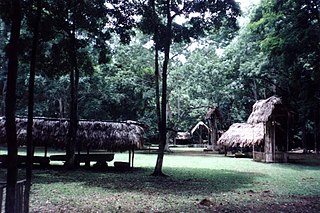
Dos Pilas is a Pre-Columbian site of the Maya civilization located in what is now the department of Petén, Guatemala. It dates to the Late Classic Period, and was founded by an offshoot of the dynasty of the great city of Tikal in AD 629 in order to control trade routes in the Petexbatún region, particularly the Pasión River. In AD 648 Dos Pilas broke away from Tikal and became a vassal state of Calakmul, although the first two kings of Dos Pilas continued to use the same emblem glyph that Tikal did. It was a predator state from the beginning, conquering Itzan, Arroyo de Piedra and Tamarindito. Dos Pilas and a nearby city, Aguateca, eventually became the twin capitals of a single ruling dynasty. The kingdom as a whole has been named as the Petexbatun Kingdom, after Lake Petexbatún, a body of water draining into the Pasión River.

Tikal is the ruin of an ancient city, which was likely to have been called Yax Mutal, found in a rainforest in Guatemala. It is one of the largest archeological sites and urban centers of the pre-Columbian Maya civilization. It is located in the archeological region of the Petén Basin in what is now northern Guatemala. Situated in the department of El Petén, the site is part of Guatemala's Tikal National Park and in 1979 it was declared a UNESCO World Heritage Site.
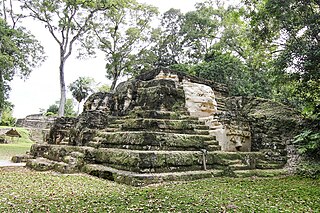
Uaxactun is an ancient sacred place of the Maya civilization, located in the Petén Basin region of the Maya lowlands, in the present-day department of Petén, Guatemala. The site lies some 12 miles (19 km) north of the major center of Tikal. The name is sometimes spelled as Waxaktun.
Futura may refer to:

Onanole is a community the Municipality of Harrison Park in Manitoba, Canada, popular as a summer colony.
Arroyo de Piedra is a pre-Columbian Maya archaeological site in Guatemala located approximately 2-3 km east/northeast of Dos Pilas and 3 km west of Tamarindito. The site dates to the middle half of the Classic period. While initially a center of some regional importance, with the rise of Dos Pilas, Arroyo de Piedra was subsumed as a secondary center within the Petexbatun region.

Nakum is a Mesoamerican archaeological site, and a former ceremonial center and city of the pre-Columbian Maya civilization. It is located in the northeastern portion of the Petén Basin region, in the modern-day Guatemalan department of Petén. The northeastern Petén region contains a good number of other significant Maya sites, and Nakum is one of the three sites forming the Cultural Triangle of "Yaxha-Nakum-Naranjo". Nakum is approximately 17 kilometres (10.6 mi) to the north of Yaxha and some 25 kilometres (15.5 mi) to the east of Tikal, on the banks of the Holmul River. Its main features include an abundance of visibly restored architecture, and the roof comb of the site's main temple structure is one of the best-preserved outside Tikal.

The Museo Nacional de Arqueología y Etnología is a national museum of Guatemala, dedicated to the conservation of archaeological and ethnological artifacts and research into Guatemala's history and cultural heritage. The museum is located in Guatemala City, at Finca La Aurora.

Premiere Club is a skyscraper in Guatemala City, Guatemala located at 4a. Avenida Final x Calle 23, in Zone14. As of 2020, it is the tallest building in Guatemala at 100.75 m (330.5 ft). The building has 31 floors and was completed in 1999.
The Atrium Building is a skyscraper in Guatemala City, Guatemala. It is a residential building located at Diagonal 6 16-01, in Zone10 of the city. At 84 metres or 275 feet , as of 2009 it is the second tallest building in Guatemala. The building has 28 floors and 138 rooms and was completed in 2008.

Cathedral of the Rockies, also known as the Cathedral of the Rockies First United Methodist Church, is a United Methodist church located in the historic North End district of Boise, Idaho, United States. The church is the largest United Methodist Church in Boise, Idaho, the largest in the Oregon-Idaho Conference of the United Methodist denomination, and was the first Methodist church in Boise, founded in 1872.
Bejucal is a Maya archaeological site in the Petén Department of Guatemala. It is located 7 kilometres (4.3 mi) northeast of El Zotz and was subservient to that city. The site is thought to date to the second half of the 4th century AD, in the Early Classic period.

Tikal Temple V is the name given by archaeologists to one of the major pyramids at Tikal. Tikal is one of the most important archaeological sites of the pre-Columbian Maya civilization and is located in the Petén Department of northern Guatemala.
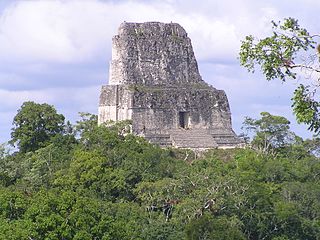
Tikal Temple IV is a Mesoamerican pyramid in the ruins of the ancient Maya city of Tikal in modern Guatemala. It was one of the tallest and most voluminous buildings in the Maya world. The pyramid was built around 741 AD. Temple IV is located at the western edge of the site core. Two causeways meet at the temple; the Tozzer Causeway runs east to the Great Plaza, while the Maudslay Causeway runs northeast to the Northern Zone. Temple IV is the second tallest pre-Columbian structure still standing in the New World, just after the Great Pyramid of Toniná in Chiapas, Mexico, although Teotihuacan's Pyramid of the Sun may once have been taller.
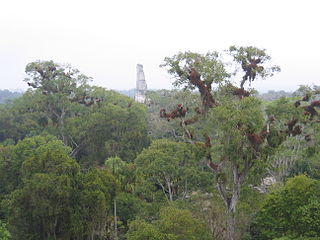
Tikal Temple III, also known as the Temple of the Jaguar Priest, was one of the principal temple pyramids at the ancient Maya city of Tikal, in the Petén Department of modern Guatemala. The temple stands approximately 55 metres (180 ft) tall. The summit shrine of Temple III differs from those of the other major temples at Tikal in that it only possesses two rooms instead of the usual three. The pyramid was built in the Late Classic Period, and has been dated to 810 AD using the hieroglyphic text on Stela 24, which was raised at the base of its access stairway. Stela 24 is paired with the damaged Altar 6, in a typical stela-altar pair.

The Plaza of the Seven Temples is an architectural complex in the ruins of the Maya city of Tikal, in the Petén Department of northern Guatemala. It is to the south of Temple III and to the west of the South Acropolis; it is 300 metres (980 ft) to the southwest of the Great Plaza. The Plaza of the Seven Temples is situated directly to the east of the Mundo Perdido Complex and takes its name from a row of seven small temples dating to the Late Classic Period. The plaza has a surface area of approximately 25,000 square metres (270,000 sq ft), making it one of the three largest plazas in the city.
José Habie Nigrin, also known as Joe or Joey Habie, was a Guatemalan businessman of paternal Jewish descent. He was the owner of the Liztex Corporation, one of the five largest exporters of fabrics in Latin America. He also owned the Tikal Futura business and hotel complex in Guatemala City. Habie died in a helicopter crash in Guatemala City on September 28, 2012. He was the sole occupant of the aircraft.
The following is a timeline of the history of Guatemala City, Republic of Guatemala.
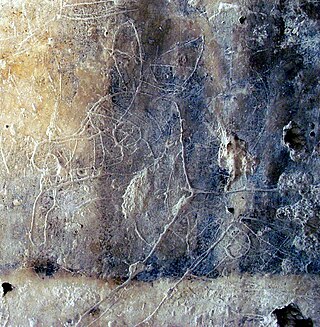
Ancient Maya graffiti are a little-studied area of folk art of the pre-Columbian Maya civilization. Graffiti were incised into the stucco of interior walls, floors, and benches, in a wide variety of buildings, including pyramid-temples, residences, and storerooms. Graffiti have been recorded at over 50 Maya sites, particularly clustered in the Petén Basin and southern Campeche, and the Chenes region of northwestern Yucatán. At Tikal, where a great quantity of graffiti have been recorded, the subject matter includes drawings of temples, people, deities, animals, banners, litters, and thrones. Graffiti were often inscribed haphazardly, with drawings overlapping each other, and display a mix of crude, untrained art, and examples by artists who were familiar with Classic-period artistic conventions.
14°37′21″N90°33′14″W / 14.62250°N 90.55389°W